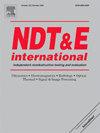Simulated delaminations in thermal NDT standards and the concept of thermally equivalent defects
IF 4.1
2区 材料科学
Q1 MATERIALS SCIENCE, CHARACTERIZATION & TESTING
引用次数: 0
Abstract
In the thermal nondestructive testing (TNDT) of composite panels NDT standards (reference panels) are used to validate TNDT procedures and to verify the effectiveness of data processing algorithms. Most composite NDT standards use Teflon implants to simulate delaminations in composite panels.
3D numerical modeling has been used to evaluate the temperature versus time behavior of Teflon/foamed polypropylene implants and FBHs to determine how the parameters of implants (dimension, thickness, number of layers) or FBHs (dimension and depth) can be optimized to provide the best possible representations of real delaminations.
An ongoing question in the TNDT “community” has been “How well do Teflon implants and FBHs represent real delaminations?”
This paper will answer this question and provide recommendations.
Following the numerical modeling, composite test panels with simulated delaminations were fabricated, they were tested by TNDT, and the results were evaluated and compared.
The concept of thermally equivalent defects is introduced. A thermally equivalent defect is an FBH or Teflon/foamed polypropylene implant that accurately represent the temperature versus time performance of a real delamination, even though the simulated defect may not be the same diameter or depth of the real delamination.
求助全文
约1分钟内获得全文
求助全文
来源期刊

Ndt & E International
工程技术-材料科学:表征与测试
CiteScore
7.20
自引率
9.50%
发文量
121
审稿时长
55 days
期刊介绍:
NDT&E international publishes peer-reviewed results of original research and development in all categories of the fields of nondestructive testing and evaluation including ultrasonics, electromagnetics, radiography, optical and thermal methods. In addition to traditional NDE topics, the emerging technology area of inspection of civil structures and materials is also emphasized. The journal publishes original papers on research and development of new inspection techniques and methods, as well as on novel and innovative applications of established methods. Papers on NDE sensors and their applications both for inspection and process control, as well as papers describing novel NDE systems for structural health monitoring and their performance in industrial settings are also considered. Other regular features include international news, new equipment and a calendar of forthcoming worldwide meetings. This journal is listed in Current Contents.
 求助内容:
求助内容: 应助结果提醒方式:
应助结果提醒方式:


